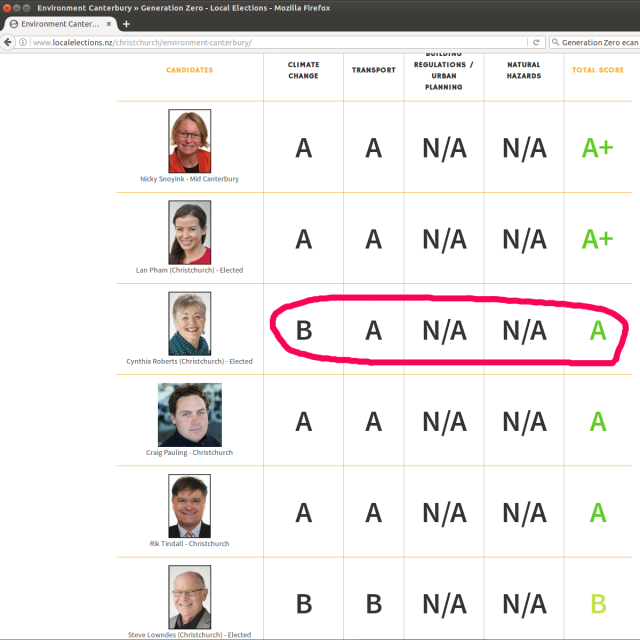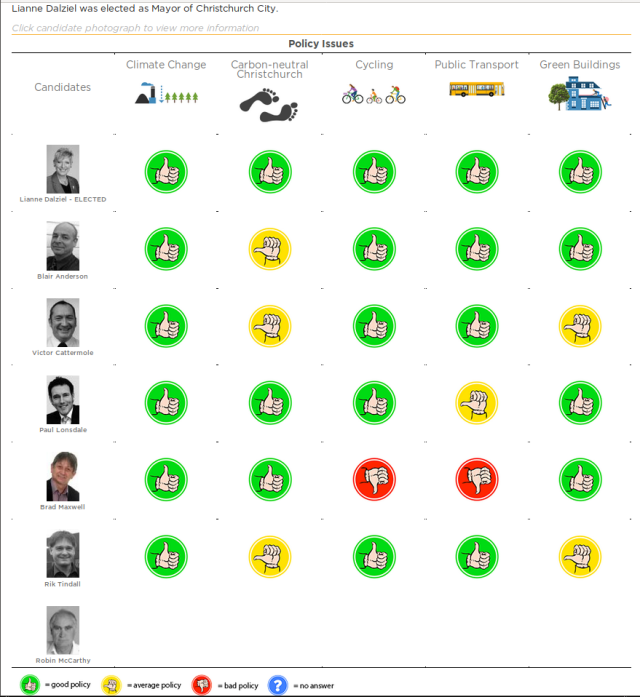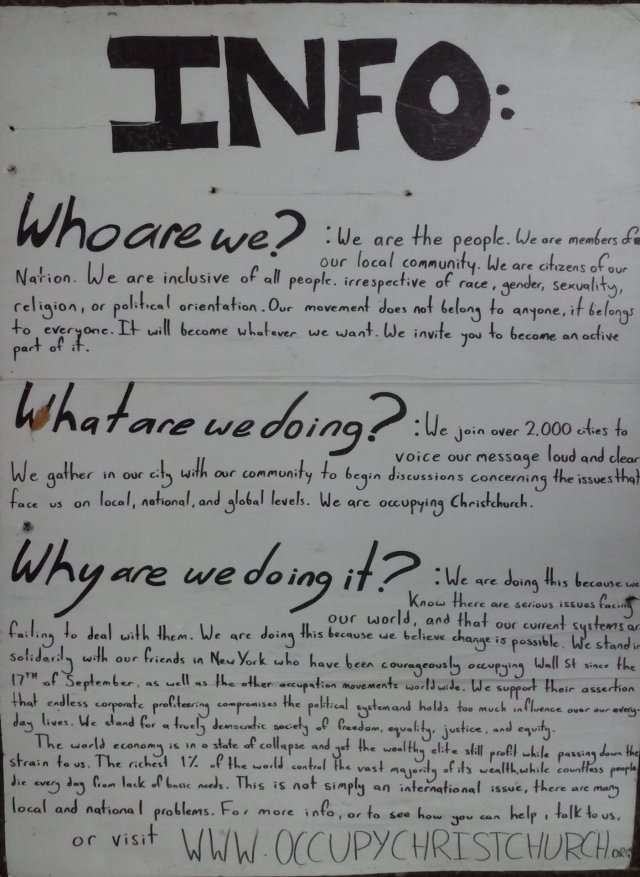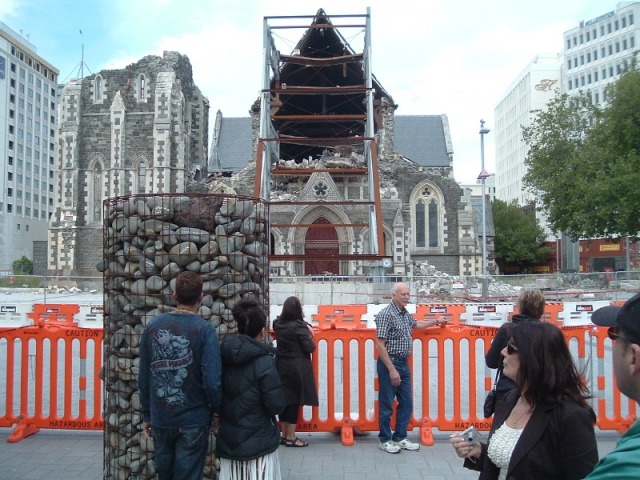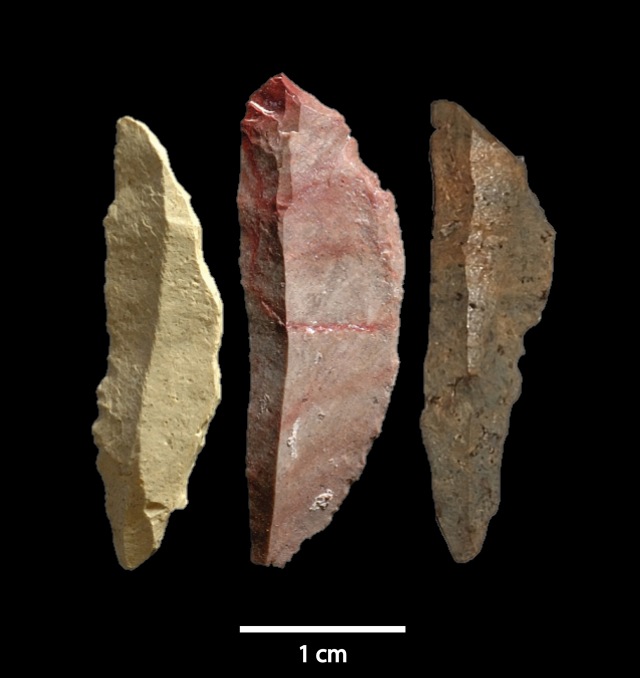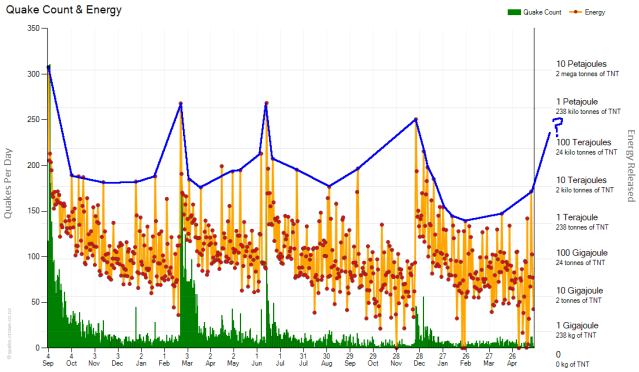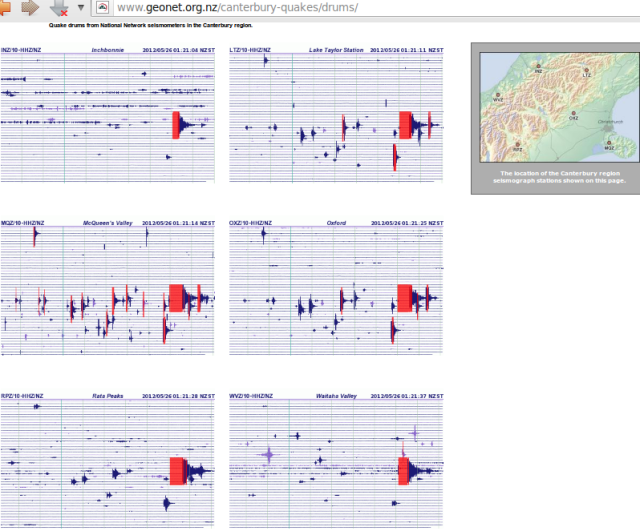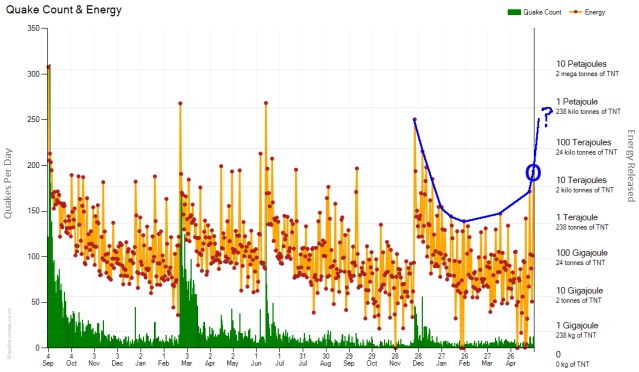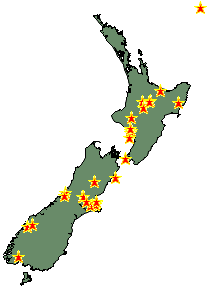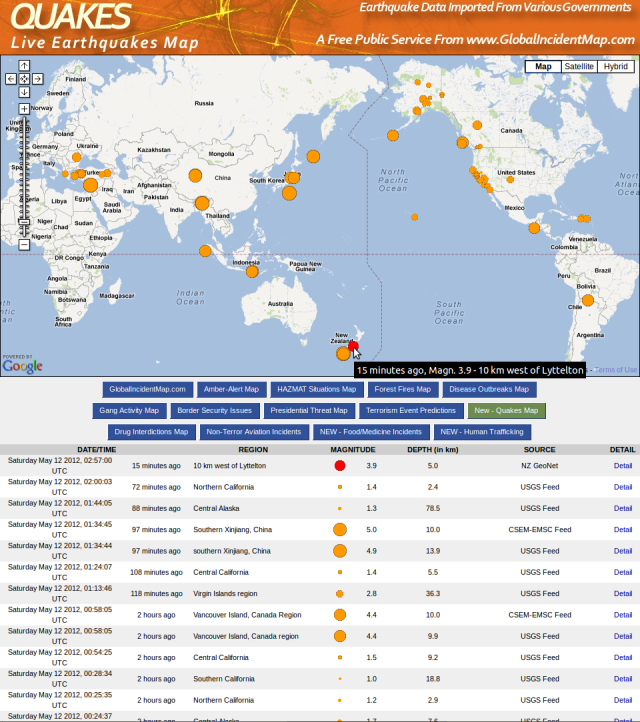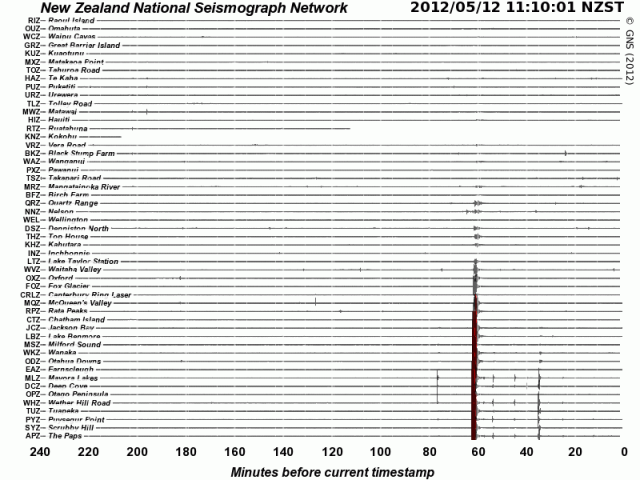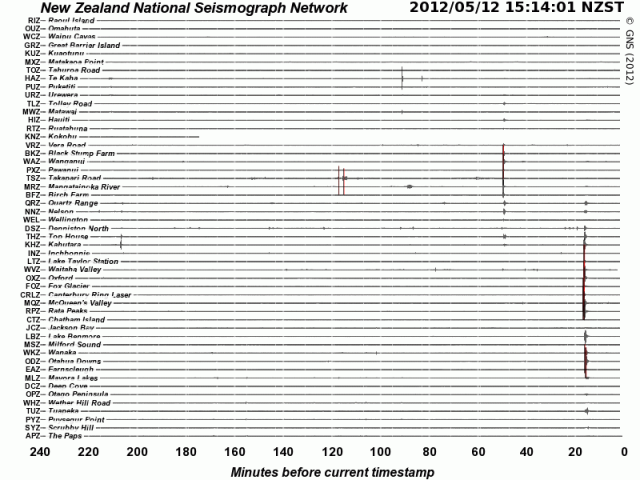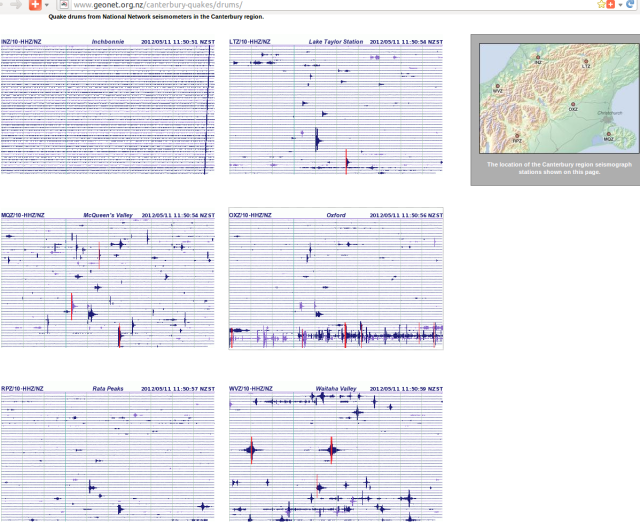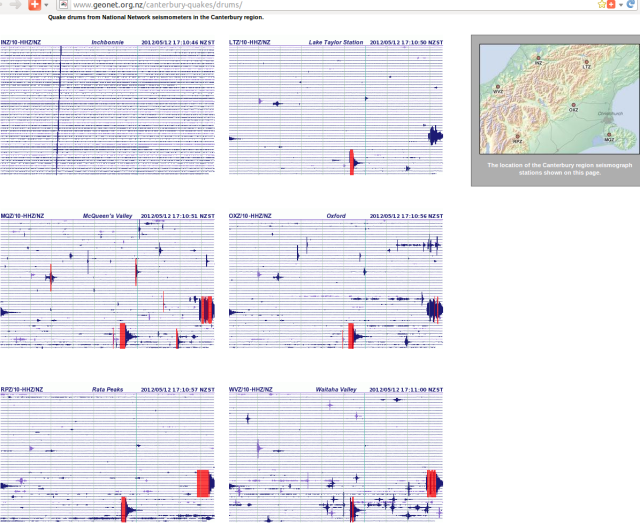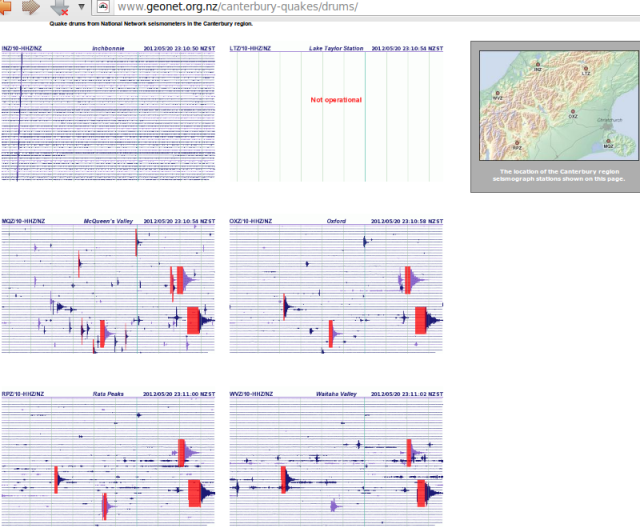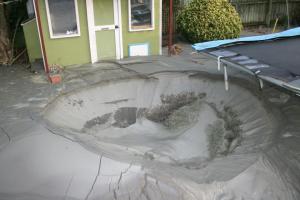Here is the global seismic backdrop to earthquake series revival in Canterbury NZ. North-south, Alaska to Antarctica, warmed Earth crust is flexing. The tectonic pressure heaviest accumulated around the slow-moving Zealandia land mass, which is mostly submerged to Christchurch’s east and south, is increasingly expressing itself. Eventually, this mass too must move – with Pacific plate expansion, driving Alpine Fault rupture towards the south-west.
Here are the three largest offshore earthquake sites from 23 December, showing their alignment with a major south-west to north-east underground fracture fault that is the product of deep subduction trench activity to the north. Note also the coincidence of the 29-30 December aftershock upsurge, as on 23 December, with equivalent force events on the Kermadec trench.
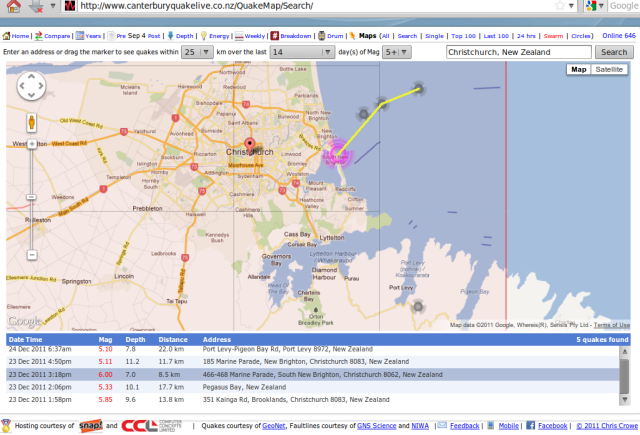
23 Dec 2011 big quakes alignment - L-R: mag' 6.0, 5.8, 5.3 - Crowe.co.nz 311211
Base graphic source:
canterburyquakelive.co.nz/QuakeMap/Search/
Update – the latest magnitude 5.1 quake 1.27am NZDT also confirms this fault alignment:
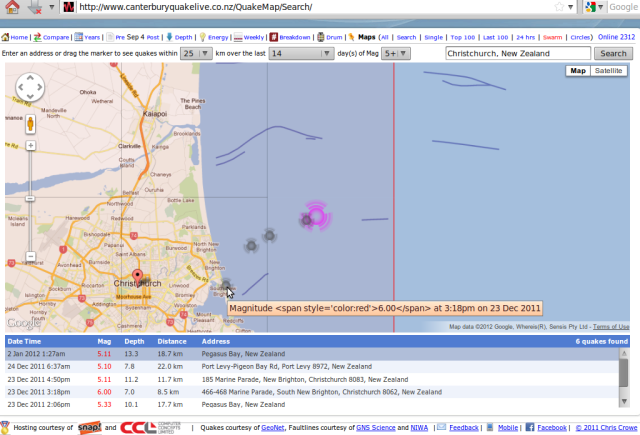
020112 Pegasus Bay mag 5.1 quake, alignment to 23 Dec 6.0 etc - Crowe.co.nz
According to
Lack of aftershocks a good sign – expert diagram from The Press of 08/07/2011, we are now witnessing the direct extension of the Port Hills Fault. Will this eventually trigger something nearer to 7, on the newly-discovered offshore Kaiapoi Fault?

Christchurch faults - The Press 060711
Theory confirmed – quakes have now reached Kaiapoi fault area … :
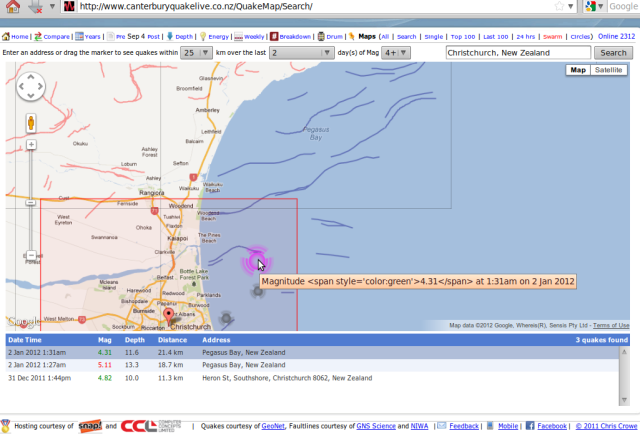
Pegasus Bay mag 5.1 quake, Kaiapoi 4.3 alignment - Crowe 020112
Update – the latest magnitude 5.4 quake 5:45am NZDT also confirms this fault alignment:
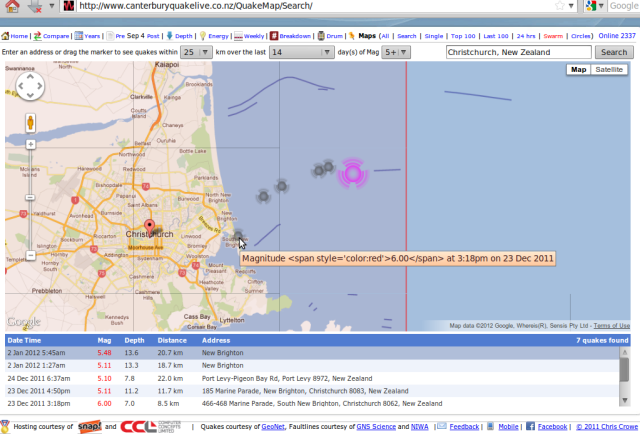
Pegasus Bay mag 5.4 quake - canterburyquakelive.co.nz 020112a
According to canterburyquakelive.co.nz and The Press Quake swarm rattles Christchurch, we just had “the 11th largest shake to hit the city” since 4 September 2010:
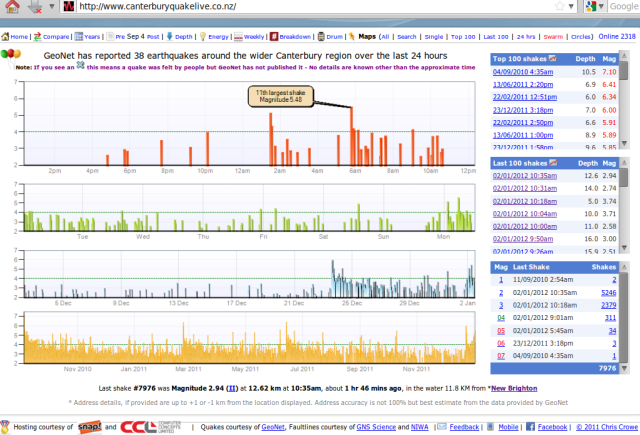
Pegasus Bay mag 5.4 quake history - Chris Crowe 020112c
Note especially the
increasing quake intensity at bottom right of these four charts.
Note: Shocks may be ‘last gasp’ of Feb 22 fault “this could be some residual activity from the eastern end of the February 22 fault that didn’t rupture all the way out there.. United States seismologist Kevin Furlong.. ‘what makes this a bit intriguing is that it has continued in such a systematic way for so long. I guess my arm-waving explanation is that the entire region was sufficiently stressed, and there were numerous fault segments, none of them particularly large, that were near failure conditions’ [! And?]” The Press 03/01/2012 + Shocks-could-trigger-exodus “those affected to maintain routines, communicate with friends and family, and seek help if needed” / GNS to give briefing on latest quakes + Earthquake woes set to intensify “Heading into 2012, many issues are set to intensify. Insurance wrangles, rising land prices and land zoning will be among contentious points as significant strides are expected to be made towards the region’s recovery. Of most concern is that about 3000 properties remain in limbo. The Canterbury Earthquake Recovery Authority has said the orange and white zones are ‘high priority’, and affected residents will be hoping for a belated Christmas present” 02/01/2012 + doubts over local science Aftershock may be one of biggest. More, refer to: [Canterbury Issues] #Chch leadership drought #NZ #CDEM
List from quakes.globalincidentmap.com (magnitude + km depth + data feed source):
Friday January 6 2012, 12:21:35 UTC South Island of New Zealand 4.5 9.9 USGS
Friday January 6 2012, 12:14:11 UTC Southern Alaska 2.9 101.1 USGS
Friday January 6 2012, 11:47:19 UTC Northern California 2.2 0.6 USGS
Friday January 6 2012, 11:29:43 UTC Northern California 1.5 2.9 USGS
Friday January 6 2012, 11:28:30 UTC Northern California 1.1 2.4 USGS
Friday January 6 2012, 11:24:40 UTC Southern Alaska 3.5 100.9 USGS
Friday January 6 2012, 10:49:33 UTC Northern California 2.6 0.2 USGS
Friday January 6 2012, 10:13:37 UTC Northern California 1.1 0.1 USGS
Friday January 6 2012, 09:04:04 UTC Island of Hawaii, Hawaii 2.0 1.5 USGS
Friday January 6 2012, 08:08:38 UTC off coast of Bio-Bio, Chile 5.0 15.2 USGS
Friday January 6 2012, 07:47:47 UTC Central California 1.2 8.0 USGS
Friday January 6 2012, 07:46:24 UTC Central California 1.3 0.0 USGS
Friday January 6 2012, 07:32:10 UTC Central California 1.1 8.1 USGS
Friday January 6 2012, 07:09:34 UTC Central California 1.2 8.1 USGS
Friday January 6 2012, 07:08:40 UTC Central California 2.1 6.6 USGS
Friday January 6 2012, 07:04:16 UTC South Island of New Zealand 4.7 11.3 USGS
Friday January 6 2012, 06:50:09 UTC Central California 3.3 7.3 USGS
Friday January 6 2012, 06:48:11 UTC Puerto Rico region 3.0 16.5 USGS
Friday January 6 2012, 06:37:20 UTC Mindoro, Philippines 4.8 169.8 USGS
Friday January 6 2012, 06:26:53 UTC Central California 2.8 6.5 USGS
Friday January 6 2012, 06:11:49 UTC northern Texas 2.0 4.9 USGS
Friday January 6 2012, 05:53:47 UTC Southern Alaska 2.9 13.2 USGS
Friday January 6 2012, 05:28:57 UTC Myanmar 4.4 54.1 USGS
Friday January 6 2012, 04:31:14 UTC New Ireland region, Papua New Guinea 4.8 80.4 USGS
[Update: pattern exactly as forecast – pix at bottom of page[1] – quake prediction service now temporarily suspended, while seeking a poll of support]
Friday January 6 2012, 04:23:16 UTC Central Alaska 2.6 104.9 USGS
Friday January 6 2012, 04:11:00 UTC off east coast North Island New Zealand 4.8 34.9 USGS
Friday January 6 2012, 04:02:47 UTC Oklahoma 2.8 2.9 USGS
Friday January 6 2012, 04:02:10 UTC Northern California 2.4 1.0 USGS
Friday January 6 2012, 03:58:49 UTC Southern Alaska 2.0 79.6 USGS
Friday January 6 2012, 02:47:50 UTC Southern California 3.1 6.9 USGS
Friday January 6 2012, 02:33:03 UTC Hawaii region, Hawaii 1.9 10.8 USGS
Friday January 6 2012, 02:14:08 UTC Santa Barbara Channel, California 3.0 7.5 USGS
Friday January 6 2012, 02:06:53 UTC Turkey-Syria-Iraq border region 4.3 4.5 USGS
Friday January 6 2012, 01:20:57 UTC South Island of New Zealand 4.5 8.4 USGS
Friday January 6 2012, 00:38:48 UTC southern Mid-Atlantic Ridge 5.1 10.0 USGS
Friday January 6 2012, 00:16:53 UTC eastern Turkey 4.6 10.0 USGS
Thursday January 5 2012, 23:52:48 UTC Virgin Islands region 3.0 35.0 USGS
Thursday January 5 2012, 23:28:44 UTC near east coast Honshu, Japan 4.9 22.0 USGS
Thursday January 5 2012, 23:14:48 UTC Kepulauan Batu, Indonesia 5.1 38.3 USGS
Thursday January 5 2012, 22:22:42 UTC offshore Baja California Sur, Mexico 4.3 15.0 USGS
Thursday January 5 2012, 22:02:40 UTC Dominican Republic 4.6 60.7 USGS
Thursday January 5 2012, 22:02:38 UTC Dominican Republic 4.0 20.0 USGS
Thursday January 5 2012, 21:55:22 UTC Pacific-Antarctic Ridge 5.2 15.9 USGS
Thursday January 5 2012, 20:55:47 UTC near east coast Honshu, Japan 5.0 45.5 USGS
Thursday January 5 2012, 20:30:53 UTC Central Alaska 2.2 123.7 USGS
Thursday January 5 2012, 19:49:43 UTC Utah 2.8 9.6 USGS
Thursday January 5 2012, 19:42:23 UTC Central Alaska 2.1 88.7 USGS
Thursday January 5 2012, 18:58:23 UTC Fox Islands, Aleutian Islands, Alaska 4.0 39.8 USGS
Thursday January 5 2012, 17:28:28 UTC Central California 2.0 10.5 USGS
Thursday January 5 2012, 17:18:14 UTC Central California 1.1 3.9 USGS
Thursday January 5 2012, 17:18:14 UTC Central California 1.1 3.9 USGS
Thursday January 5 2012, 16:53:39 UTC southern Iran 5.0 32.5 USGS
Thursday January 5 2012, 16:47:05 UTC near the east coast of Honshu, Japan 5.1 20.1 USGS
Thursday January 5 2012, 16:29:28 UTC Southern Alaska 2.2 27.3 USGS
Thursday January 5 2012, 16:26:27 UTC Tonga 4.5 197.6 USGS
Thursday January 5 2012, 16:25:40 UTC Northern California 2.0 8.9 USGS
Thursday January 5 2012, 16:07:09 UTC Southern California 2.0 7.7 USGS
Thursday January 5 2012, 16:00:49 UTC Alabama 2.9 7.6 USGS
Thursday January 5 2012, 16:00:48 UTC Alabama 2.9 1.0 USGS
Thursday January 5 2012, 15:24:13 UTC Puerto Rico region 3.9 112.0 USGS
Thursday January 5 2012, 14:05:04 UTC Central California 1.9 4.8 USGS
Thursday January 5 2012, 13:52:29 UTC Central California 2.1 9.8 USGS
Thursday January 5 2012, 13:51:54 UTC Island of Hawaii, Hawaii 2.7 6.6 USGS
Thursday January 5 2012, 13:45:23 UTC Alaska Peninsula 2.6 5.6 USGS
Thursday January 5 2012, 13:05:24 UTC Southern Alaska 2.0 37.7 USGS
Thursday January 5 2012, 12:51:35 UTC Southern Alaska 2.1 109.2 USGS
Thursday January 5 2012, 12:27:57 UTC Central Alaska 2.1 0.0 USGS
Thursday January 5 2012, 12:16:40 UTC Central California 3.0 10.4 USGS
Thursday January 5 2012, 10:15:12 UTC western Montana 2.4 11.7 USGS
Thursday January 5 2012, 10:15:12 UTC western Montana 1.7 5.6 USGS
Thursday January 5 2012, 09:35:29 UTC Dominican Republic 5.3 10.0 USGS
Thursday January 5 2012, 09:15:34 UTC offshore Guatemala 4.4 66.1 USGS
Thursday January 5 2012, 09:14:41 UTC Southeastern Alaska 2.6 2.0 USGS
Thursday January 5 2012, 09:00:03 UTC Southern California 2.6 2.1 USGS
Thursday January 5 2012, 08:51:29 UTC Central California 1.1 4.0 USGS
Thursday January 5 2012, 07:56:37 UTC Crete, Greece 4.5 41.1 USGS
Thursday January 5 2012, 07:34:00 UTC Southern Alaska 2.0 16.8 USGS
Thursday January 5 2012, 07:20:10 UTC southern Idaho 3.4 4.9 USGS
Thursday January 5 2012, 06:10:18 UTC Northern California 2.1 18.4 USGS
Thursday January 5 2012, 06:10:18 UTC Northern California 1.9 18.3 USGS
Thursday January 5 2012, 06:03:06 UTC Northern California 1.0 1.2 USGS
Thursday January 5 2012, 04:48:32 UTC Kenai Peninsula, Alaska 2.3 78.7 USGS
Thursday January 5 2012, 04:37:43 UTC Central Alaska 2.2 107.0 USGS
Thursday January 5 2012, 04:08:04 UTC Southern Alaska 2.0 23.9 USGS
Thursday January 5 2012, 02:08:59 UTC Central California 2.1 8.0 USGS
Thursday January 5 2012, 01:19:55 UTC Sulawesi, Indonesia 4.8 97.0 USGS
[Update: 4.8 quake strikes Christchurch “tremor struck at 8.28am and was 15 kilometres deep and 10km east of the city.. centred in Pegasus Bay, where numerous quakes have been centred since the swarm on December 23” stuff.co.nz 08:45 05/01/2012 NZDT – expect more 5+ Antarctic plate rim quakes south of NZ, then rising Chch aftershocks again soon after those..]
Wednesday January 4 2012, 20:10:19 UTC Central Alaska 2.2 0.0 USGS
Wednesday January 4 2012, 19:53:36 UTC Santa Cruz Islands 5.1 43.2 USGS
Wednesday January 4 2012, 18:57:00 UTC Santa Cruz Islands 5.2 101.6 USGS
Wednesday January 4 2012, 18:30:58 UTC Southern California 2.1 6.7 USGS
Wednesday January 4 2012, 18:29:43 UTC Southern California 1.2 30.8 USGS
Wednesday January 4 2012, 18:25:42 UTC Southern California 2.2 5.5 USGS
Wednesday January 4 2012, 18:18:45 UTC Central California 1.4 9.9 USGS
Wednesday January 4 2012, 18:14:24 UTC near the north coast of New Guinea, Papua New Guinea 4.7 122.5 USGS
Wednesday January 4 2012, 18:04:30 UTC Tonga region 4.9 20.5 USGS [ = the current quake energy focus.. south-west Pacific, moving east]
Wednesday January 4 2012, 17:24:31 UTC Southern Alaska 3.8 135.6 USGS
Wednesday January 4 2012, 16:51:43 UTC Pakistan 4.8 10.0 USGS
Wednesday January 4 2012, 16:31:29 UTC southwestern Kashmir 4.2 40.5 USGS
Wednesday January 4 2012, 16:25:37 UTC Southeastern Alaska 4.3 17.8 USGS
Wednesday January 4 2012, 16:25:36 UTC British Columbia, Canada 4.3 7.0 USGS
Wednesday January 4 2012, 16:25:35 UTC Canada 4.4 92.0 Natural Resources Canada
Wednesday January 4 2012, 16:25:35 UTC Canada 4.2 90.0 Natural Resources Canada
Wednesday January 4 2012, 16:15:32 UTC Southern Yukon Territory, Canada 2.0 17.8 USGS
Wednesday January 4 2012, 16:12:53 UTC Central Alaska 2.5 36.4 USGS
Wednesday January 4 2012, 16:01:46 UTC Washington 2.4 0.8 USGS
Wednesday January 4 2012, 15:35:51 UTC Kepulauan Barat Daya, Indonesia 5.2 149.9 USGS
Wednesday January 4 2012, 15:12:26 UTC Puerto Rico region 2.6 15.3 USGS
Wednesday January 4 2012, 14:30:16 UTC Central Alaska 2.0 95.1 USGS
Wednesday January 4 2012, 14:30:16 UTC Central Alaska 2.1 95.3 USGS
Wednesday January 4 2012, 14:21:21 UTC Izu Islands, Japan region 4.7 407.3 USGS
Wednesday January 4 2012, 13:56:17 UTC Puerto Rico 2.1 6.0 USGS
Wednesday January 4 2012, 13:45:06 UTC Central Alaska 2.4 13.0 USG
Wednesday January 4 2012, 13:08:11 UTC southwestern Siberia, Russia 4.7 10.0 USG
Wednesday January 4 2012, 12:43:30 UTC Northern California 2.1 2.6 USGS
Wednesday January 4 2012, 11:49:40 UTC Mona Passage, Puerto Rico 2.7 11.0 USGS
Wednesday January 4 2012, 11:07:20 UTC Central Alaska 2.4 12.7 USGS
Wednesday January 4 2012, 11:07:21 UTC Central Alaska 2.1 18.1 USGS
Wednesday January 4 2012, 10:57:32 UTC Northern California 1.9 1.9 USGS
Wednesday January 4 2012, 09:22:13 UTC Virgin Islands region 3.1 126.0 USGS [ = the current quake energy focus.. south-Central Pacific, moving south]
Wednesday January 4 2012, 08:41:37 UTC Puerto Rico region 3.4 75.9 USGS
Wednesday January 4 2012, 06:59:57 UTC Taiwan 4.4 11.5 USGS
Wednesday January 4 2012, 06:48:06 UTC Central Alaska 2.0 13.5 USGS
Wednesday January 4 2012, 06:47:21 UTC Baja California, Mexico 2.8 6.5 USGS
Wednesday January 4 2012, 06:28:33 UTC Southern California 2.2 13.9 USGS
Wednesday January 4 2012, 06:25:12 UTC Northern California 2.8 3.0 USGS
Wednesday January 4 2012, 06:22:34 UTC Northern California 1.2 3.1 USGS
Wednesday January 4 2012, 06:16:54 UTC Southern Alaska 2.0 23.1 USGS
Wednesday January 4 2012, 05:57:45 UTC Southeastern Alaska 2.3 0.1 USGS
Wednesday January 4 2012, 04:47:35 UTC Vanuatu 5.2 233.1 USGS
Wednesday January 4 2012, 04:41:06 UTC south of Sumba, Indonesia 4.8 26.9 USGS
Wednesday January 4 2012, 04:32:18 UTC Island of Hawaii, Hawaii 1.7 10.4 USGS
Wednesday January 4 2012, 04:20:49 UTC Unimak Island region, Alaska 2.7 41.9 USGS
Wednesday January 4 2012, 03:58:51 UTC Southern California 1.4 8.9 USGS
Wednesday January 4 2012, 03:53:40 UTC Southern California 2.0 10.9 USGS
Wednesday January 4 2012, 03:38:56 UTC Southern California 1.6 7.4 USGS
Wednesday January 4 2012, 02:35:12 UTC Island of Hawaii, Hawaii 1.7 6.2 USGS
Wednesday January 4 2012, 02:07:52 UTC Ryukyu Islands, Japan 4.9 21.9 USGS
Wednesday January 4 2012, 01:49:13 UTC Bonin Islands, Japan region 4.8 9.3 USGS [ = the current quake energy focus.. north-Central Pacific, moving south]
Wednesday January 4 2012, 00:26:01 UTC Southern Alaska 3.9 136.8 USGS
Tuesday January 3 2012, 23:35:57 UTC Island of Hawaii, Hawaii 2.4 6.9 USGS
Tuesday January 3 2012, 22:03:16 UTC British Columbia, Canada 2.1 0.0 USGS
Tuesday January 3 2012, 21:50:27 UTC offshore Bio-Bio, Chile 4.6 32.6 USGS
Tuesday January 3 2012, 21:32:37 UTC Puerto Rico region 3.2 51.5 USGS
Tuesday January 3 2012, 21:12:48 UTC San Francisco Bay area, California 2.2 10.6 USGS
Tuesday January 3 2012, 21:00:26 UTC Island of Hawaii, Hawaii 1.8 6.2 USGS
Tuesday January 3 2012, 18:29:13 UTC Puerto Rico region 2.5 11.0 USGS
Tuesday January 3 2012, 18:11:00 UTC Unimak Island region, Alaska 2.4 41.5 USGS
Tuesday January 3 2012, 17:55:33 UTC Nevada 2.3 13.7 USGS
Tuesday January 3 2012, 15:40:02 UTC Guam region 5.2 35.5 USGS
Tuesday January 3 2012, 14:18:56 UTC Channel Islands region, California 4.1 18.4 USGS
Tuesday January 3 2012, 13:32:54 UTC Hawaii region, Hawaii 3.7 44.5 USGS
Tuesday January 3 2012, 13:32:56 UTC Hawaii region, Hawaii 3.4 15.5 USGS
Tuesday January 3 2012, 13:02:39 UTC Central Alaska 1.8 0.4 USGS
Tuesday January 3 2012, 12:20:17 UTC Kuril Islands 4.9 43.5 USGS
Tuesday January 3 2012, 10:56:57 UTC Oklahoma 3.2 4.9 USGS
Tuesday January 3 2012, 08:41:37 UTC Fox Islands, Aleutian Islands, Alaska 4.5 99.8 USGS
Tuesday January 3 2012, 07:57:31 UTC Central Alaska 1.5 7.4 USGS
Tuesday January 3 2012, 07:40:01 UTC southern Xinjiang, China 4.5 44.2 USGS
Tuesday January 3 2012, 07:20:49 UTC Central Alaska 2.1 94.0 USGS
Tuesday January 3 2012, 07:13:31 UTC Central Alaska 1.5 115.8 USGS
Tuesday January 3 2012, 07:10:54 UTC Southern Alaska 2.4 24.5 USGS
Tuesday January 3 2012, 07:10:44 UTC Northern California 2.4 2.8 USGS
Tuesday January 3 2012, 06:09:48 UTC Fox Islands, Aleutian Islands, Alaska 2.8 24.9 USGS
Tuesday January 3 2012, 05:46:52 UTC south of Alaska 3.0 29.5 USGS [= the current quake energy focus.. North Pacific]
Tuesday January 3 2012, 04:02:00 UTC Central Alaska 2.4 74.8 USGS
Tuesday January 3 2012, 03:29:06 UTC San Pedro Channel, California 2.2 0.1 USGS
Tuesday January 3 2012, 03:16:33 UTC Greater Los Angeles area, California 2.0 13.0 USGS
Tuesday January 3 2012, 03:06:24 UTC Alaska Peninsula 3.8 46.9 USGS
Tuesday January 3 2012, 02:58:51 UTC Central Alaska 2.6 16.0 USGS
Tuesday January 3 2012, 02:11:33 UTC Southern California 2.0 2.4 USGS
Tuesday January 3 2012, 01:30:57 UTC Baja California, Mexico 2.9 12.2 USGS
Tuesday January 3 2012, 00:42:13 UTC British Columbia, Canada 2.1 0.0 USGS
Tuesday January 3 2012, 00:20:29 UTC Central Alaska 2.0 14.7 USGS
Monday January 2 2012, 22:04:57 UTC Nevada 1.9 4.8 USGS
Monday January 2 2012, 22:02:09 UTC Island of Hawaii, Hawaii 1.8 6.3 USGS
Monday January 2 2012, 21:56:58 UTC Nevada 1.8 0.1 USGS
Monday January 2 2012, 21:31:11 UTC Gulf of Alaska 3.3 10.9 USGS
Monday January 2 2012, 21:15:46 UTC Island of Hawaii, Hawaii 2.4 4.9 USGS
Monday January 2 2012, 19:14:10 UTC Kodiak Island region, Alaska 2.3 13.2 USGS
Monday January 2 2012, 18:15:53 UTC Central Alaska 2.0 9.9 USGS
Monday January 2 2012, 17:08:50 UTC Northern California 1.0 2.2 USGS
Monday January 2 2012, 16:41:26 UTC Northern California 1.2 2.0 USGS
Monday January 2 2012, 16:30:31 UTC Northern California 2.1 6.3 USGS
Monday January 2 2012, 16:06:23 UTC Fox Islands, Aleutian Islands, Alaska 3.7 17.6 USGS
Monday January 2 2012, 16:04:21 UTC Northern California 1.7 2.4 USGS
Monday January 2 2012, 15:55:27 UTC Northern California 1.5 2.1 USGS
Monday January 2 2012, 15:54:43 UTC Northern California 3.0 2.4 USGS
Monday January 2 2012, 15:23:25 UTC Southern Alaska 2.6 44.7 USGS
Monday January 2 2012, 15:23:25 UTC Southern Alaska 2.7 40.3 USGS
Monday January 2 2012, 14:23:52 UTC Southern Alaska 2.5 107.0 USGS
Monday January 2 2012, 14:19:01 UTC Alaska Peninsula 1.8 1.3 USGS
Monday January 2 2012, 14:14:56 UTC Central Alaska 2.1 10.4 USGS
Monday January 2 2012, 13:21:23 UTC Central Alaska 3.2 15.0 USGS
Monday January 2 2012, 13:20:34 UTC Puerto Rico region 2.6 4.2 USGS
Monday January 2 2012, 13:10:29 UTC Virgin Islands region 3.3 12.0 USGS
Monday January 2 2012, 13:07:08 UTC New Ireland region, Papua New Guinea 4.7 10.0 USGS
Monday January 2 2012, 12:58:42 UTC Central California 1.8 3.8 USGS
Monday January 2 2012, 12:50:08 UTC Central Alaska 2.0 130.1 USGS
Monday January 2 2012, 12:45:21 UTC Central Alaska 1.7 5.4 USGS
Monday January 2 2012, 12:25:35 UTC Island of Hawaii, Hawaii 3.0 0.0 USGS
Monday January 2 2012, 11:53:26 UTC Virgin Islands region 3.0 52.0 USGS
Monday January 2 2012, 11:18:32 UTC Central California 1.4 5.5 USGS
Monday January 2 2012, 11:18:05 UTC Central California 2.1 4.0 USGS
Monday January 2 2012, 11:11:24 UTC Central Alaska 2.4 0.0 USGS
Monday January 2 2012, 11:08:46 UTC Southern Alaska 2.3 4.8 USGS
Monday January 2 2012, 10:42:01 UTC Virgin Islands region 2.9 61.0 USGS
Monday January 2 2012, 10:40:33 UTC Virgin Islands region 2.7 58.0 USGS
Monday January 2 2012, 10:32:28 UTC Unimak Island region, Alaska 2.1 9.3 USGS
Monday January 2 2012, 09:49:49 UTC Central Alaska 2.0 116.4 USGS
Monday January 2 2012, 09:39:57 UTC northern Mid-Atlantic Ridge 4.8 10.0 USGS
Monday January 2 2012, 08:55:12 UTC Rat Islands, Aleutian Islands, Alaska 4.9 89.6 USGS
Monday January 2 2012, 08:34:27 UTC Kenai Peninsula, Alaska 2.4 46.6 USGS
Monday January 2 2012, 08:27:59 UTC Kenai Peninsula, Alaska 1.8 93.7 USGS
Monday January 2 2012, 07:02:46 UTC offshore Northern California 2.8 16.3 USGS
Monday January 2 2012, 06:53:27 UTC Central California 2.2 4.0 USGS
Monday January 2 2012, 06:38:31 UTC Southern Alaska 2.7 71.5 USGS
Monday January 2 2012, 06:36:29 UTC Gulf of Santa Catalina, California 2.0 0.1 USGS
Monday January 2 2012, 05:59:14 UTC South Island of New Zealand 4.5 13.2 USGS
Monday January 2 2012, 05:24:23 UTC Northern California 1.9 2.3 USGS
Monday January 2 2012, 05:09:15 UTC Northern California 1.1 2.5 USGS
Monday January 2 2012, 04:58:38 UTC Central Alaska 3.0 152.8 USGS
Monday January 2 2012, 04:04:11 UTC Southern Alaska 2.4 90.7
Monday January 2 2012, 03:57:59 UTC Northern California 1.1 3.1 USGS
Monday January 2 2012, 03:25:31 UTC Northern California 1.5 2.7 USGS
Monday January 2 2012, 03:09:12 UTC Southern California 2.4 18.6 USGS
Monday January 2 2012, 01:30:32 UTC Southern Alaska 2.2 35.4 USGS
Monday January 2 2012, 01:29:05 UTC Alaska Peninsula 2.0 25.3 USGS
Monday January 2 2012, 00:52:56 UTC Central Alaska 2.0 13.6 USGS
Monday January 2 2012, 00:52:49 UTC Northern California 2.0 2.5 USGS
Monday January 2 2012, 00:16:09 UTC Southern California 1.6 2.8 USGS
Sunday January 1 2012, 23:57:21 UTC Romania 4.2 33.2 USGS
Sunday January 1 2012, 23:56:22 UTC Southern California 1.8 5.6 USGS
Sunday January 1 2012, 23:26:01 UTC Southern California 2.1 1.2 USGS
Sunday January 1 2012, 22:59:13 UTC Vanuatu 5.1 32.2 USGS
Sunday January 1 2012, 21:27:00 UTC Southern Alaska 2.3 14.7 USGS
Sunday January 1 2012, 21:07:28 UTC Halmahera, Indonesia 5.0 87.1 USGS
Sunday January 1 2012, 20:06:21 UTC Northern California 2.0 1.8 USGS
Sunday January 1 2012, 19:32:51 UTC Bougainville region, Papua New Guinea 4.9 146.0 USGS
Sunday January 1 2012, 19:14:43 UTC Central Alaska 2.5 123.1 USGS
Sunday January 1 2012, 18:16:17 UTC Utah 2.2 0.2 USGS
Sunday January 1 2012, 18:09:01 UTC northern Sumatra, Indonesia 5.3 1.0 USGS
Sunday January 1 2012, 17:22:08 UTC Central California 2.3 1.3 USGS
Sunday January 1 2012, 16:45:05 UTC South Island of New Zealand 5.0 19.4 USGS
Sunday January 1 2012, 15:57:06 UTC Puerto Rico region 2.6 4.1 USGS
Sunday January 1 2012, 15:47:36 UTC Northern California 2.2 3.6 USGS
Sunday January 1 2012, 15:45:52 UTC Northern California 1.6 5.4 USGS
Sunday January 1 2012, 15:44:15 UTC south of the Mariana Islands 5.1 22.2 USGS
Sunday January 1 2012, 14:59:30 UTC San Francisco Bay area, California 2.5 1.6 USGS
Sunday January 1 2012, 14:52:49 UTC Northern California 2.2 3.4 USGS
Sunday January 1 2012, 14:48:42 UTC south of Panama 4.4 10.1 USGS
Sunday January 1 2012, 14:28:08 UTC Central Alaska 2.2 0.0 USGS
Sunday January 1 2012, 13:32:20 UTC Southern Alaska 2.6 198.9 USG
Sunday January 1 2012, 13:32:20 UTC Southern Alaska 2.5 200.2 USGS
Sunday January 1 2012, 12:27:56 UTC South Island of New Zealand 5.0 13.8 USGS
Sunday January 1 2012, 11:59:05 UTC south of the Kermadec Islands 4.9 42.9 USGS
Sunday January 1 2012, 11:49:06 UTC Central California 2.0 9.2 USGS
Sunday January 1 2012, 11:30:20 UTC Central Alaska 2.3 0.0 USGS
Sunday January 1 2012, 09:29:48 UTC Southern California 2.1 8.6 USGS
Sunday January 1 2012, 09:29:43 UTC off east coast Honshu, Japan 4.7 10.0 USGS
Sunday January 1 2012, 09:29:48 UTC off east coast Honshu, Japan 4.6 45.7 USGS
Sunday January 1 2012, 09:29:48 UTC Southern California 2.1 8.6 USGS
Sunday January 1 2012, 08:53:49 UTC Southern California 2.2 7.4 USGS
Sunday January 1 2012, 08:31:26 UTC near the east coast of Honshu, Japan 4.5 43.1 USGS
Sunday January 1 2012, 08:29:44 UTC Island of Hawaii, Hawaii 1.7 32.5 USGS
Sunday January 1 2012, 07:40:27 UTC offshore Guatemala 4.3 71.5 USGS
Sunday January 1 2012, 06:52:17 UTC Mona Passage, Puerto Rico 3.0 17.0 USGS
Sunday January 1 2012, 05:48:29 UTC Central Alaska 2.3 22.7 USGS
Sunday January 1 2012, 05:27:54 UTC Izu Islands, Japan region 6.8 348.5 USGS
Sunday January 1 2012, 05:19:39 UTC Andaman Islands, India region 4.6 31.8 USGS
Sunday January 1 2012, 04:56:41 UTC Pacific-Antarctic Ridge 5.1 10.0 USGS
Sunday January 1 2012, 04:39:21 UTC Southern Alaska 2.0 24.0 USGS
Sunday January 1 2012, 02:40:36 UTC northern Colombia 4.0 158.1 USGS
Sunday January 1 2012, 02:35:19 UTC Tripura, India region 4.6 15.2 USGS
Sunday January 1 2012, 01:02:45 UTC Central Alaska 2.5 0.0 USGS
Sunday January 1 2012, 00:50:09 UTC Santa Cruz Islands 5.2 77.6 USGS
Sunday January 1 2012, 00:43:05 UTC Southern Alaska 2.1 142.2 USGS
Sunday January 1 2012, 00:37:25 UTC Central Alaska 3.0 63.3 USGS
Sunday January 1 2012, 00:30:06 UTC south of the Mariana Islands 5.1 18.1 USGS
Saturday December 31 2011, 22:49:33 UTC Bonin Islands, Japan region 4.8 694.1 USGS
Saturday December 31 2011, 20:35:03 UTC Southern Alaska 2.4 97.0 USGS
Saturday December 31 2011, 20:05:01 UTC Youngstown-Akron urban area, Ohio 4.0 5.0 USGS
Saturday December 31 2011, 20:04:58 UTC Youngstown-Akron urban area, Ohio 4.0 2.2 USGS
Saturday December 31 2011, 19:39:50 UTC Central Alaska 3.2 23.5 USGS
Saturday December 31 2011, 19:14:45 UTC Baja California, Mexico 3.2 12.7 USGS
Saturday December 31 2011, 17:10:33 UTC off coast Costa Rica 4.6 51.8 USGS
Saturday December 31 2011, 16:36:05 UTC Nevada 2.0 21.3 USGS
Saturday December 31 2011, 16:32:49 UTC Northern California 1.6 2.2 USGS
Saturday December 31 2011, 16:15:08 UTC Salta, Argentina 5.3 13.1 USGS
Saturday December 31 2011, 15:12:15 UTC Northern California 1.1 0.7 USGS
Saturday December 31 2011, 15:05:16 UTC Northern California 2.2 0.9 USGS
Saturday December 31 2011, 14:53:14 UTC Northern California 1.8 2.6 USGS
Saturday December 31 2011, 14:40:56 UTC Central Alaska 2.2 83.9 USGS
Saturday December 31 2011, 14:33:19 UTC Central Alaska 2.2 111.5 USGS
Saturday December 31 2011, 14:31:02 UTC Central Alaska 1.6 4.5 USGS
Saturday December 31 2011, 14:13:17 UTC Southern Alaska 1.9 15.0 USGS
Saturday December 31 2011, 13:42:16 UTC Northern California 1.3 2.7 USGS
Saturday December 31 2011, 13:20:42 UTC Central California 1.9 5.0 USGS
Saturday December 31 2011, 13:16:27 UTC Southern California 1.5 0.1 USGS
Saturday December 31 2011, 12:47:11 UTC Northern California 1.9 2.6 USGS
Saturday December 31 2011, 11:43:57 UTC Northern California 1.4 2.7 USGS
Saturday December 31 2011, 10:47:55 UTC Nevada 2.0 6.5 USGS
Saturday December 31 2011, 10:23:16 UTC Fox Islands, Aleutian Islands, Alaska 3.0 29.0 USGS
Saturday December 31 2011, 10:20:56 UTC Island of Hawaii, Hawaii 2.9 37.7 USGS
Saturday December 31 2011, 09:55:00 UTC offshore Guatemala 4.3 60.5 USGS
Saturday December 31 2011, 09:13:17 UTC Turkey-Iran-Iraq border region 4.4 18.7 USGS
Saturday December 31 2011, 08:56:54 UTC Northern California 2.1 2.3 USGS
Saturday December 31 2011, 08:07:18 UTC Oklahoma 3.5 5.0 USGS
Saturday December 31 2011, 07:43:59 UTC Nevada 1.7 0.2 USGS
Saturday December 31 2011, 07:06:00 UTC Island of Hawaii, Hawaii 1.9 32.8 USGS
Saturday December 31 2011, 06:14:42 UTC Kepulauan Sula, Indonesia 4.9 42.1 USGS
Saturday December 31 2011, 05:39:52 UTC Pakistan 4.9 31.3 USGS
Saturday December 31 2011, 05:02:07 UTC Central California 2.4 4.6 USGS
Saturday December 31 2011, 04:49:59 UTC Northern California 1.4 1.6 USGS
Saturday December 31 2011, 04:30:26 UTC Northern California 1.5 2.3 USGS
Saturday December 31 2011, 04:25:37 UTC Northern California 2.0 2.9 USGS
Saturday December 31 2011, 04:05:44 UTC Kepulauan Sula, Indonesia 4.8 19.8 USGS
Saturday December 31 2011, 03:57:03 UTC Banda Sea 4.6 73.1 USGS
Saturday December 31 2011, 03:54:11 UTC Oklahoma 2.1 5.0 USGS
Saturday December 31 2011, 03:10:08 UTC Island of Hawaii, Hawaii 2.7 7.7 USGS
Saturday December 31 2011, 01:30:22 UTC Kenai Peninsula, Alaska 2.3 47.8 USGS
Saturday December 31 2011, 01:29:36 UTC Kenai Peninsula, Alaska 2.4 39.8 USGS
Saturday December 31 2011, 01:20:30 UTC Puerto Rico region 2.7 28.4 USGS
Saturday December 31 2011, 01:07:27 UTC Southern California 2.2 3.7 USGS
Saturday December 31 2011, 00:53:56 UTC Colombia 4.7 106.0 USGS
Saturday December 31 2011, 00:44:46 UTC South Island of New Zealand 5.3 10.1 USGS
Saturday December 31 2011, 00:24:26 UTC New Guinea, Papua New Guinea 4.9 37.5 USGS
Saturday December 31 2011, 00:08:27 UTC Southern Alaska 2.0 59.9 USGS
Friday December 30 2011, 23:11:07 UTC near east coast Honshu, Japan 4.8 20.9 USGS
Friday December 30 2011, 23:06:13 UTC northern Alaska 2.2 4.6 USGS
Friday December 30 2011, 22:58:27 UTC Southern Alaska 2.0 61.9 USGS
Friday December 30 2011, 22:55:32 UTC Northern California 2.1 29.4 USGS
Friday December 30 2011, 22:35:40 UTC Northern California 1.9 1.8 USGS
Friday December 30 2011, 22:30:20 UTC south of Kermadec Islands 4.7 41.1 USGS
Friday December 30 2011, 22:25:41 UTC Northern California 2.1 30.1 USGS
Friday December 30 2011, 22:15:49 UTC Northern California 1.6 33.7 USGS
Friday December 30 2011, 22:04:07 UTC Northern California 1.4 31.2 USGS
Friday December 30 2011, 21:43:19 UTC south of the Kermadec Islands 5.2 34.6 USGS
Friday December 30 2011, 20:42:46 UTC Greater Los Angeles area, California 1.6 16.0 USGS
Friday December 30 2011, 20:03:47 UTC San Francisco Bay area, California 1.5 0.7 USGS
Friday December 30 2011, 18:49:59 UTC Vanuatu region 4.9 26.2 USGS
Friday December 30 2011, 17:29:54 UTC south of Kermadec Islands 5.0 9.8 USGS
Friday December 30 2011, 17:29:33 UTC Central California 2.3 7.8 USGS
Friday December 30 2011, 17:24:29 UTC Alaska Peninsula 2.9 200.4 USGS
Friday December 30 2011, 17:13:57 UTC Central Alaska 2.9 141.4 USGS
Friday December 30 2011, 17:07:21 UTC Izu Islands, Japan region 5.2 397.9 USGS
Friday December 30 2011, 16:34:34 UTC South Sandwich Islands region 5.2 106.2 USGS
Friday December 30 2011, 16:32:44 UTC Baja California, Mexico 2.7 10.0 USGS
Friday December 30 2011, 16:31:18 UTC Southern California 2.0 12.6 USGS
Friday December 30 2011, 16:19:06 UTC Central California 2.2 4.4 USGS
Friday December 30 2011, 16:09:32 UTC western Montana 3.2 6.2 USGS
Friday December 30 2011, 15:55:54 UTC Baja California, Mexico 3.0 21.1 USGS
Friday December 30 2011, 15:55:54 UTC Baja California, Mexico 2.8 10.0 USGS
Friday December 30 2011, 15:50:12 UTC Baja California, Mexico 3.1 10.0 USGS
Friday December 30 2011, 15:48:23 UTC Virgin Islands region 3.4 72.4 USGS
Friday December 30 2011, 15:34:29 UTC Baja California, Mexico 4.3 10.0 USGS
Friday December 30 2011, 14:18:52 UTC Nevada 2.4 11.7 USGS
31 Dec 2011 1:44pm NZDT Heron St, Southshore, Christchurch 8062, New Zealand 4.82 10.0 Crowe
Friday December 30 2011, 13:17:58 UTC Guam region 4.6 19.1 USGS
Friday December 30 2011, 12:59:52 UTC Baja California, Mexico 2.9 20.9 USGS
Friday December 30 2011, 12:35:19 UTC Rat Islands, Aleutian Islands, Alaska 4.5 30.2 USGS
Friday December 30 2011, 12:23:17 UTC near east coast Kamchatka Peninsula, Russia 4.4 55.9 USGS
Friday December 30 2011, 12:17:44 UTC Pacific-Antarctic Ridge 4.6 10.0 USGS
Friday December 30 2011, 12:10:06 UTC Utah 1.6 0.3 USGS
Friday December 30 2011, 12:10:06 UTC Northern California 2.3 2.7 USGS
Friday December 30 2011, 12:06:18 UTC Island of Hawaii, Hawaii 1.7 6.4 USGS
Friday December 30 2011, 11:53:54 UTC Southern Alaska 3.0 62.2 USGS
Friday December 30 2011, 10:49:31 UTC Canada 2.6 46.0 Natural Resources Canada
Friday December 30 2011, 10:49:30 UTC Maine 2.0 7.7 USGS
Friday December 30 2011, 10:35:30 UTC Hawaii region, Hawaii 2.6 39.4 USGS
Friday December 30 2011, 09:36:29 UTC south of the Fiji Islands 4.7 221.2 USGS
Friday December 30 2011, 09:34:50 UTC near east coast Honshu, Japan 4.6 68.0 USGS
Friday December 30 2011, 09:22:16 UTC near coast central Peru 5.1 51.3 USGS
Friday December 30 2011, 08:51:58 UTC southern Sumatra, Indonesia 5.5 60.8 USGS
Friday December 30 2011, 08:46:42 UTC New Britain region, Papua New Guinea 5.0 53.5 USGS
Friday December 30 2011, 08:42:23 UTC Southern Yukon Territory, Canada 2.1 13.0 USGS
Friday December 30 2011, 08:11:29 UTC Long Valley area, California 1.4 3.1 USGS
Friday December 30 2011, 08:05:45 UTC Rat Islands, Aleutian Islands, Alaska 4.7 62.9 USGS
Friday December 30 2011, 08:03:43 UTC Canada 2.5 84.0 Natural Resources Canada
Friday December 30 2011, 07:41:28 UTC Canada 2.5 23.0 Natural Resources Canada
Friday December 30 2011, 07:13:02 UTC Ecuador 4.6 126.4 USGS
Friday December 30 2011, 06:26:05 UTC Canada 3.2 25.0 Natural Resources Canada
Friday December 30 2011, 06:00:07 UTC Greater Los Angeles area, California 1.4 16.7 USGS
Friday December 30 2011, 05:35:07 UTC San Francisco Bay area, California 1.9 5.8 USGS
Friday December 30 2011, 05:30:52 UTC Central California 1.7 4.7 USGS
Friday December 30 2011, 05:25:22 UTC Southern California 2.1 6.2 USGS
Friday December 30 2011, 04:59:52 UTC Hokkaido, Japan region 4.4 67.0 USGS
2011/12/30 03:46:15 FIJI REGION 4.4 513.6 USGS
Friday December 30 2011, 02:46:42 UTC Southern California 2.0 6.9 USGS
Friday December 30 2011, 02:29:53 UTC Southern California 1.8 10.6 USGS
Friday December 30 2011, 02:18:50 UTC Central California 3.0 9.3 USGS
Friday December 30 2011, 01:45:02 UTC Halmahera, Indonesia 4.8 87.3 USGS
Friday December 30 2011, 00:35:47 UTC eastern Turkey 4.3 4.9 USGS
Thursday December 29 2011, 22:56:01 UTC Central California 2.3 6.7 USGS
Thursday December 29 2011, 22:54:11 UTC Southern California 2.4 18.8 USGS
Thursday December 29 2011, 22:25:50 UTC Bougainville region, Papua New Guinea 5.3 505.0 USGS
Thursday December 29 2011, 20:34:59 UTC offshore Chiapas, Mexico 4.6 102.0 USGS
Thursday December 29 2011, 20:05:50 UTC Vanuatu 5.3 40.9 USGS
Thursday December 29 2011, 19:19:54 UTC Baja California, Mexico 2.8 22.4 USGS
Thursday December 29 2011, 18:28:18 UTC Fox Islands, Aleutian Islands, Alaska 4.4 25.6 USGS
Thursday December 29 2011, 18:17:33 UTC Central California 1.7 1.8 USGS
Thursday December 29 2011, 17:15:20 UTC Central California 2.0 4.9 USGS
30 Dec 2011 4:45am NZDT 351 Kainga Rd, Brooklands, Christchurch 8083, New Zealand 4.37 13.0 Crowe
Thursday December 29 2011, 16:31:53 UTC Central Alaska 2.5 21.8 USGS
Thursday December 29 2011, 15:06:31 UTC southeastern Missouri 2.8 7.8 USGS
Thursday December 29 2011, 13:58:55 UTC south of the Kermadec Islands 4.6 248.8 USGS
Thursday December 29 2011, 13:45:41 UTC near the coast of central Peru 4.8 77.5 USGS
Thursday December 29 2011, 12:54:09 UTC Oregon 1.6 3.4 USGS
Thursday December 29 2011, 12:53:04 UTC Oregon 1.9 9.6 USGS
Thursday December 29 2011, 11:58:29 UTC northern Colombia 4.3 147.3 USGS
Thursday December 29 2011, 11:48:10 UTC western Texas 2.5 4.9 USGS
29 Dec 2011 10:48pm NZDT 165E Rocking Horse Rd, Southshore, Christchurch 8062, New Zealand 4.32 12.1 Crowe
Thursday December 29 2011, 10:40:06 UTC Puerto Rico region 2.1 19.0 USGS
Thursday December 29 2011, 09:03:36 UTC western Montana 2.2 12.3 USGS
Thursday December 29 2011, 08:58:03 UTC Puerto Rico region 2.7 29.2 USGS
Thursday December 29 2011, 08:08:42 UTC Central California 2.1 6.1 USGS
Thursday December 29 2011, 07:51:04 UTC Northern California 2.2 6.1 USGS
Thursday December 29 2011, 07:48:17 UTC Northern California 2.1 0.3 USGS
Thursday December 29 2011, 07:25:10 UTC Southern Alaska 2.0 4.8 USGS
Thursday December 29 2011, 07:17:00 UTC Central Alaska 2.0 3.6 USGS
Thursday December 29 2011, 07:13:46 UTC Central Alaska 1.7 0.0 USGS
Thursday December 29 2011, 06:46:38 UTC Utah 1.5 6.9 USGS
Thursday December 29 2011, 06:44:46 UTC Utah 1.6 8.6 USGS
Thursday December 29 2011, 05:40:21 UTC Canada 2.2 93.0 Natural Resources Canada
Thursday December 29 2011, 05:19:58 UTC Guatemala 4.6 10.2 USGS
Thursday December 29 2011, 05:06:41 UTC Kodiak Island region, Alaska 3.6 58.2 USGS
Thursday December 29 2011, 04:41:05 UTC Fox Islands, Aleutian Islands, Alaska 2.9 4.2 USGS
Thursday December 29 2011, 04:18:38 UTC Southern Alaska 2.4 20.5 USGS
Thursday December 29 2011, 04:09:15 UTC Northern California 2.4 1.5 USGS
Thursday December 29 2011, 03:32:46 UTC southern Peru 4.6 197.3 USGS
Thursday December 29 2011, 01:12:03 UTC Southern California 2.5 16.7 USGS
Thursday December 29 2011, 00:49:47 UTC Northern California 2.4 2.6 USGS
Thursday December 29 2011, 00:30:56 UTC Pacific-Antarctic Ridge 5.5 16.9 USGS
Wednesday December 28 2011, 23:39:22 UTC Central Alaska 1.0 0.3 USGS
Wednesday December 28 2011, 23:21:03 UTC Central Alaska 2.0 31.1 USGS
Wednesday December 28 2011, 23:05:37 UTC Nevada 1.7 25.8 USGS
Wednesday December 28 2011, 22:47:13 UTC Central Alaska 2.0 1.9 USGS
Wednesday December 28 2011, 22:11:47 UTC British Columbia, Canada 2.4 0.0 USGS
Wednesday December 28 2011, 21:56:32 UTC Alaska Peninsula 2.2 1.3 USGS
Wednesday December 28 2011, 21:55:43 UTC Tonga 5.1 238.9 USGS
Wednesday December 28 2011, 21:45:53 UTC Oaxaca, Mexico 4.4 64.3 USGS
Wednesday December 28 2011, 21:03:33 UTC Southern California 1.4 17.3 USGS
Wednesday December 28 2011, 20:45:33 UTC San Francisco Bay area, California 1.5 0.1 USGS
Wednesday December 28 2011, 20:32:31 UTC South Sandwich Islands region 5.4 31.0 USGS
Wednesday December 28 2011, 18:42:02 UTC Puerto Rico region 2.5 72.2 USGS
Wednesday December 28 2011, 18:16:04 UTC Kenai Peninsula, Alaska 2.4 33.4 USGS
Wednesday December 28 2011, 18:14:34 UTC Southern California 2.1 4.0 USGS
Wednesday December 28 2011, 17:57:28 UTC Greater Los Angeles area, California 2.2 5.1 USGS
Wednesday December 28 2011, 17:50:12 UTC Southern Alaska 2.6 105.4 USGS
Wednesday December 28 2011, 17:33:55 UTC Halmahera, Indonesia 5.4 159.7 USGS
Wednesday December 28 2011, 16:47:30 UTC Greater Los Angeles area, California 1.9 5.7 USGS
Wednesday December 28 2011, 16:27:39 UTC Mindanao, Philippines 4.6 87.6 USGS
Wednesday December 28 2011, 16:12:22 UTC Canada 2.7 35.0 Natural Resources Canada
Wednesday December 28 2011, 15:49:28 UTC northern Alaska 3.0 11.1 USGS
Wednesday December 28 2011, 15:25:42 UTC southwestern Siberia, Russia 4.6 15.5 USGS
Wednesday December 28 2011, 15:20:42 UTC San Francisco Bay area, California 1.9 7.0 USGS
Wednesday December 28 2011, 15:19:57 UTC Island of Hawaii, Hawaii 1.8 6.3 USGS
Wednesday December 28 2011, 14:53:36 UTC Kodiak Island region, Alaska 2.8 11.7 USGS
Wednesday December 28 2011, 14:23:50 UTC southwest of Sumatra, Indonesia 4.7 17.9 USGS
Wednesday December 28 2011, 14:00:35 UTC Baja California, Mexico 2.1 9.8 USGS
Wednesday December 28 2011, 13:54:34 UTC southwestern Siberia, Russia 4.6 10.0 USGS
Wednesday December 28 2011, 13:13:03 UTC Puerto Rico region 2.8 101.5 USGS
Wednesday December 28 2011, 12:45:11 UTC Fox Islands, Aleutian Islands, Alaska 2.2 77.9 USGS
Wednesday December 28 2011, 11:43:41 UTC Atacama, Chile 4.9 41.9 USGS
Wednesday December 28 2011, 11:05:10 UTC New Mexico 2.5 5.0 USGS
Wednesday December 28 2011, 10:45:41 UTC Canada 2.6 32.0 Natural Resources Canada
Wednesday December 28 2011, 10:35:37 UTC New Britain region, Papua New Guinea 4.4 35.0 USGS
Wednesday December 28 2011, 10:07:05 UTC Puerto Rico region 3.0 17.3 USGS
Wednesday December 28 2011, 09:18:32 UTC Kuril Islands 4.7 62.0 USGS
Wednesday December 28 2011, 08:28:35 UTC Virgin Islands region 2.5 25.6 USGS
Wednesday December 28 2011, 06:59:14 UTC Southern California 2.9 8.5 USGS
Wednesday December 28 2011, 06:38:59 UTC Fiji region 5.2 613.7 USGS
List follows on from NZ Kermadec quakes on page; extract:
Friday December 23 2011, 17:37:30 UTC South Island of New Zealand 5.0 7.6 USGS
Friday December 23 2011, 10:52:06 UTC south of the Kermadec Islands 5.5 10.0 USGS
Friday December 23 2011, 03:50:12 UTC east coast South Island New Zealand 4.8 8.4 USGS
Friday December 23 2011, 02:18:02 UTC South Island of New Zealand 5.9 4.9 USGS
Friday December 23 2011, 01:41:37 UTC South Island of New Zealand 4.0 11.2 USGS
Friday December 23 2011, 01:30:24 UTC South Island of New Zealand 4.2 5.0 USGS
Friday December 23 2011, 01:06:25 UTC South Island of New Zealand 5.3 3.7 USGS
Wednesday December 21 2011, 13:37:14 UTC south of Kermadec Islands 5.5 10.0 USGS
= Magnitude 5.7, Thursday, December 22 2011 at 2:37 am (NZDT), 200 km south of L’Esperance Rock GeoNet
[1]

Pegasus Bay and East Cape NZ mag 5.0 quakes - GNS seismograph drums 060112e
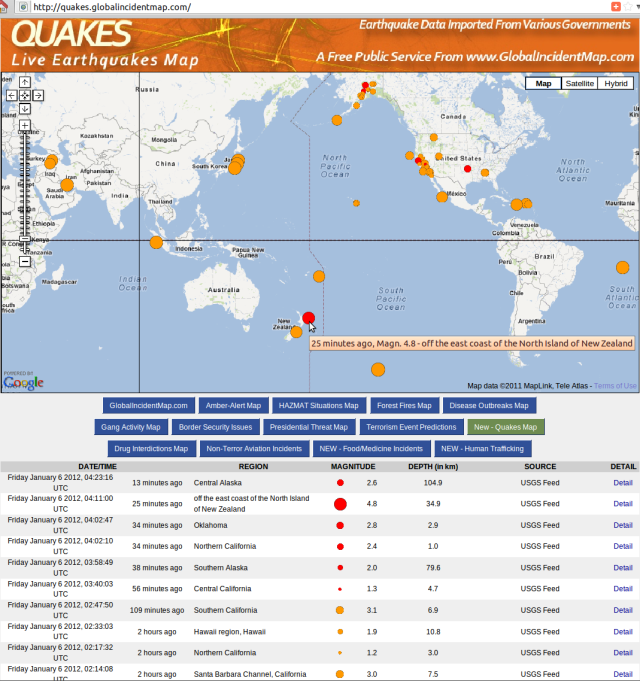
Pegasus Bay and East Cape NZ mag 5.0 quakes - GIM 060112
